I am building a video game overlay that sends data back to the player to create a custom HUD, just for fun. I am trying to read an image of a video game compass and determine the exact orientation of the compass to be a part of my HUD.
Example photo which shows the compass at the top of the screen:
(The circle currently facing ~170°, NOTE: The position of the compass is also fixed)
Example photo which shows the compass at the top of the screen:
Obviously, when I image process on the compass I will only be looking at the compass and not the whole screen.
This has been more challenging for me compared to previous computer vision aspects of my HUD. I have been trying to process the image using cv2 and from there use some object detection to find the "needle" of the compass.
I am struggling to get a triangle shape detection on either needle that will help me know my orientation.
The solution could be lower-tech and hackier, perhaps just searching for the pixel on the edge of the compass and determining that is the end of the needle.
One solution I do not think is viable is using object detection to find a picture of a compass facing true north and then calculating the rotation of the current compass. This is due to the fact that the background of the compass does not rotate only the needle does.
So far I have applied Hough Circle Transform as seen here: https://opencv24-python-tutorials.readthedocs.io/en/latest/py_tutorials/py_imgproc/py_houghcircles/py_houghcircles.html#hough-circles Which has helped me get a circle around my compass as well as the middle of my compass. However, I cannot find a good solution for finding the facing of the needle compared to the middle of the compass.
I understand this is a pretty open-ended question but I am looking for any theoretical solutions that would help me implement a solution. Anything would help as this is a strange problem for me and I am struggling to think how to go about solving it.





